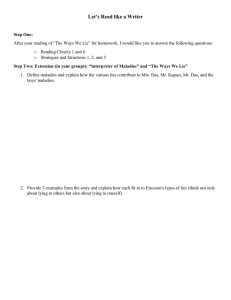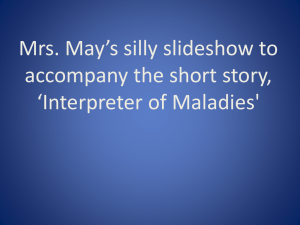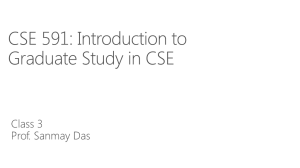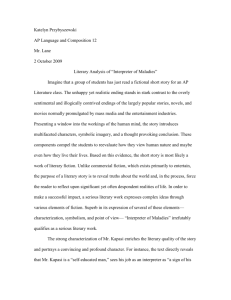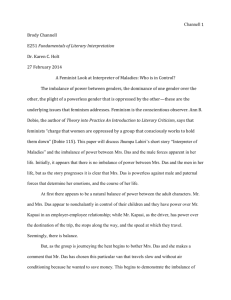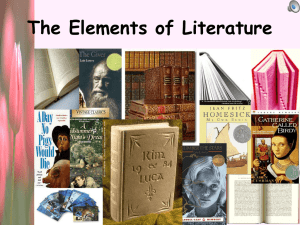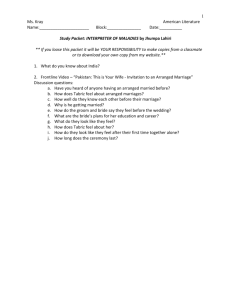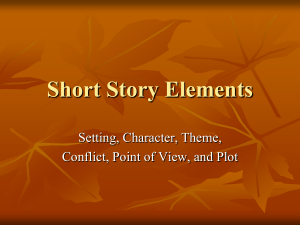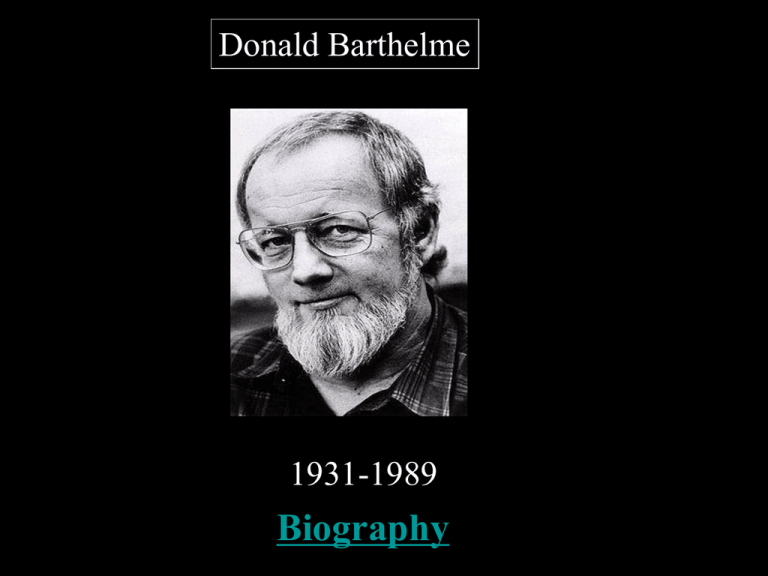
Donald Barthelme
1931-1989
Biography
Possible Theme for the Barthelme Story
Rather than question the soundness of their own
specious moral principles, some closely-knit,
secretive, male-dominated organizations may
revert to unethical and/or illegal behavior
just to uphold them.
“Interpreter of Maladies”
Limited Omniscient: the short story is told in the
third person from the viewpoint of one character
(usually the central figure). Authors tell us what this
character sees and hears and what he or she thinks
and feels, They know everything about their point of
view character--often more than the character knows
about him or herself. They limit themselves to this
character’s perceptions and thus show no direct
knowledge about what other characters are thinking
or feeling or doing, except for what the p.o.v. character
knows or can infer about them.
Jhumpa Lahiri
Born 1967
Biographical Information
“Interpreter of Maladies”
From even the expository section of the story, a reader
can depict an international theme: the disparity between
the Americanized Das family and the older, more traditional
(Indian) Mr. Kapasi. One of the major events/symbols driving this
theme is their arrival at the Sun Temple of Konarak, par 91.
Temple at Konarak
One of the Twenty four wheels
Hanuman
Cultural Values
Protagonist
Mr. Kapasi
Antagonist
Mrs. das / Das family
traditional Indian morality
superficial American culture
idealistic romance
raw sexuality/ animality
attracted to artful,
meaningful constructs of
language (interpretation)
culturally unevolved state
of sensibilities, crass, obtuse
honest in feelings
living in dishonest marriage
for eight years
portrayed as a man of
substance and imagination
adults: Portrayed as
overgrown children
Discussion question
Do you think the limited omniscient (central
intelligence) pov is most effective for this story?
Discussion question
After completing the story, what are your
feelings about Mrs. Das and Mr. Kapasi?
Empathy? Sympathy? Pity? Resentment?
Other?
Discussion question
Some who analyze the story (myself included)
see Mr. Kapasi’s mid-life crisis as central to his
feelings about Mrs. Das after her “romantic”
proclamation in paragraph 61. But we think his
are not the expected lubricious fantasies of a sexual
encounter but instead a return to his youthful dreams of
language. Agree? Disagree?
Discussion question
Discussion question
What symbolism do you see in the last
paragraph’s description of the piece of film
magazine floating up to where the monkeys are
sitting in the trees?
Discussion question
Theme for “Interpreter of Maladies”
Some men that experience midlife tribulations--whose
domestic life is physically comfortable but spiritually
unfulfilling and lacking in romance--may construct a
fantasy life around another woman to bolster their
attachment to idealistic romance and youthful dreams, not
expecting a sudden truth to shatter their world and effect
the continuation of their melancholy solitude.
John Steinbeck
1902-1968
Biography
“The Chrysanthemums”
Objective (Dramatic): the narrator disappears into a
kind of roving sound camera; this camera can go
anywhere but can only record what is seen and heard.
Readers are placed in the position of spectators at a
movie or play. They see what the characters do and
hear what they say but must infer what they think
or feel and what they are like. The purest example of
this p.o.v. would be a story written entirely in dialogue.
“The Chrysanthemums”
Discussion questions
Elisa has been called “a complex study in frustration.”
Discussion questions
How does Steinbeck’s choice of the dramatic (cinematic)
point of view add to or detract from this?
Would another point of view, say first person or limited
omniscient, have helped you to better understand Elisa’s
frustrations, or are we better off not having more detailed
explanations of what is going on in her mind?
Discussion question
Early on, Steinbeck incorporates description of the setting-particularly the Salinas Valley and the house behind Elisa.
How does this help the reader in understanding the
protagonist’s plight?
Discussion question
Critic David Hunt sees the story as a paean to feminism,
not as narrative about a pathetically weak woman
oppressed by a superior patriarchal society. Which side
are you on?
Protagonist
Elisa
strong and intense
has feminine talents
has compassion, a sense
of the romantic, trust,
concern for others
guilt-ridden
Antagonist
A society based on
masculine ideals
barriers
suppressed by economic
necessities
men are self-serving and
superficial, lack romance
Dispassionate
The dramatic point of view serves to enhance our sense of what strengths the
protagonist has, what she longs for but will, perhaps, never achieve.
Theme for “The Chrysanthemums”
For some strong, energetic women who want to
break free of traditional barriers, to realize their
spiritual and erotic cravings, to release their
nurturing qualities and feminine talents in a wider
world, the forces of a male dominated society may
too powerfully stunt their capacities for growth
and expression, thus perpetuating the frustration of
their present condition.

